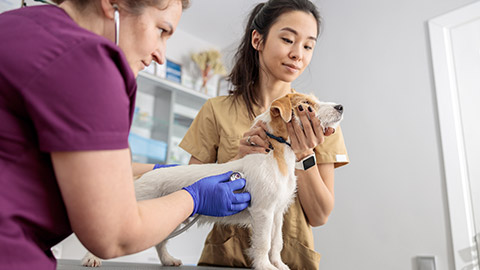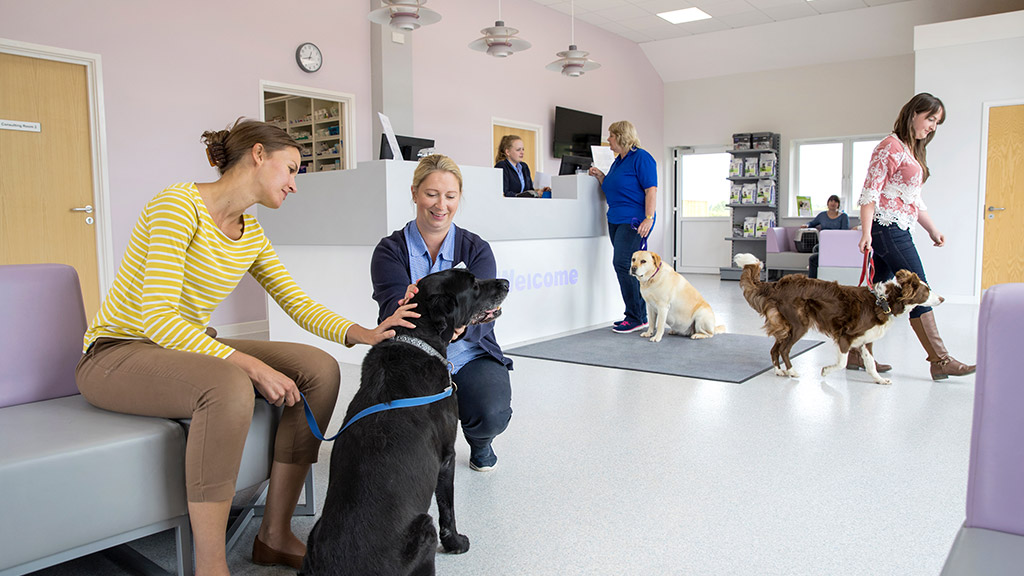The importance of ensuring the availability and functionality of appropriate personal protective equipment (PPE) cannot be overstated. PPE is a crucial component of workplace safety, serving as the last line of defence against potential hazards. Where there are inherent risks related to animal behaviour, zoonotic diseases, and the handling of potentially dangerous substances, the proper use of PPE is essential for several reasons.
- Worker Safety: PPE, when used correctly, acts as a barrier between employees and potential risks. It shields workers from injuries such as bites, scratches, or exposure to allergens and pathogens that may lead to zoonotic diseases. By ensuring the availability and functionality of appropriate PPE, employers prioritise the safety and health of their employees, reducing the risk of injuries and illnesses.
- Preventing Disease Transmission: In animal care, zoonotic diseases can be transmitted from animals to humans. PPE, including gloves, masks, and protective clothing, plays a critical role in preventing the transmission of diseases. When employees have access to and use appropriate PPE, they reduce the risk of contracting diseases such as Q fever or psittacosis, safeguarding their health and preventing the potential spread of diseases within the workplace.
- Legal Compliance: Compliance with PPE requirements is often mandated by law and workplace health and safety regulations. Failing to provide and ensure the use of appropriate PPE can result in legal consequences and penalties for employers. By maintaining the availability and functionality of PPE, employers demonstrate their commitment to legal compliance and employee well-being.
- Employee Confidence: When employees have confidence in the availability and functionality of PPE, they are more likely to perform their duties with a sense of security. This leads to increased morale, reduced stress, and higher job satisfaction, ultimately enhancing overall productivity and work quality in the animal care setting.
Necessary PPE in Animal Care
Disposable gloves are crucial for protecting hands when handling animals, especially when there is a risk of bites or scratches. They also prevent direct contact with animal waste and bodily fluids.
Respiratory masks are used to protect against airborne particles and allergens, reducing the risk of inhaling pathogens or allergens that can lead to respiratory illnesses.
Safety goggles or face shields are necessary when there is a risk of splashes, debris, or chemical exposure that could harm the eyes.
Full-body coveralls or smocks are essential to prevent direct contact with animal waste, dust, and allergens. They provide a barrier between the employee and potential contaminants.
Sturdy, closed-toe shoes or boots are needed to protect the feet from animal bites, falls, and potential exposure to hazardous substances on the floor.
In environments with loud noise, earplugs or earmuffs are necessary to prevent hearing damage.
Helmets or hard hats may be required in situations where there is a risk of falling objects or head injuries, although this is less common in animal care compared to other industries.
Respirators may be needed in situations where employees are exposed to hazardous dust, fumes, or aerosols that could cause respiratory problems.
By ensuring that these types of personal protective equipment are readily available and maintained for employees, employers demonstrate their commitment to safety and health, protecting workers and preventing accidents and injuries.

The importance of implementing processes to confirm that others in the work group can identify hazards, assess risks, assess required risk controls, follow safe work practices, and observe organisational policies and procedures is multifaceted and instrumental for a safe and effective work environment.
When all members of a work group can identify hazards and assess associated risks, it leads to early detection and mitigation of potential dangers. This proactive approach prevents accidents and injuries, reducing both human suffering and operational disruptions. Moreover, it enhances the overall efficiency of work processes by minimising unexpected setbacks.
When employees can identify hazards and understand required risk controls, they are better equipped to follow safe work practices. This not only protects them from harm but also maintains the safety and integrity of the work environment. Safe work practices are critical for preventing accidents, illnesses, and potential damage to equipment and property, which ultimately benefits the organisation.
Ensuring that employees observe organisational policies and procedures is essential for maintaining a structured and consistent work environment. It fosters legal compliance, which is crucial for avoiding penalties and regulatory issues. Additionally, adherence to established policies and procedures promotes a culture of responsibility and accountability among workers.
The ability of work group members to identify hazards, assess risks, and follow established procedures contributes to knowledge transfer and continuity within the organisation. It ensures that best practices are consistently applied, even as employees change roles or depart from the organisation, which is essential for maintaining a high standard of safety and efficiency.
Empowering employees to actively participate in the identification of hazards and risk assessment cultivates a sense of ownership and engagement in workplace safety. When employees feel they have a say in their safety and well-being, they are more likely to embrace safety practices and participate in continuous improvement initiatives.
In summary, implementing processes to confirm that work group members can identify hazards, assess risks, evaluate required risk controls, follow safe work practices, and observe organisational policies and procedures is a cornerstone of a safe and well-organized work environment. It minimises risks, promotes safety, ensures legal compliance, and empowers employees, all of which contribute to a productive and responsible workplace.
Common Organisation Processes and Their Implementation
Effective organisation processes for ensuring personal protective equipment (PPE) and emergency equipment availability and functionality, as well as checking the knowledge and skills of work group members, are critical for maintaining the safety of both employees and animals. Moreover, identifying training needs, addressing them, and reporting health and safety matters, especially in emergency situations, are essential components of a well-managed facility. Let's explore each of these processes in more detail:
- PPE Availability: The organisation should maintain an inventory of PPE, such as gloves, masks, eye protection, and protective clothing, ensuring they are readily available for employees. PPE must be appropriate for the tasks and risks involved.
- PPE Maintenance: Regular checks and maintenance procedures should be established to ensure that PPE remains in good condition. This includes regular inspections, repairs, and replacements.
- Emergency Equipment: Facilities must be equipped with emergency equipment like eyewash stations, emergency showers, fire extinguishers, and first-aid supplies. Regular inspections and maintenance of these items are crucial to ensure they function as intended.
- Training Programs: The organisation should provide comprehensive training programs that cover animal care, safe handling techniques, disease prevention, and emergency response. This training ensures that work group members have the knowledge and skills required for their roles.
- Competency Assessment: Regular competency assessments, practical demonstrations, and knowledge tests should be conducted to confirm that employees are capable of safely performing their tasks.
- Regular Assessments: Periodic assessments of the work group's skills and knowledge are essential to identify gaps and training needs. These assessments can be performed through observations, interviews, or written tests.
- Incident Analysis: Analysis of incidents or near misses can help pinpoint areas where additional training may be necessary to prevent similar occurrences in the future.
- Customised Training Plans: Once training needs are identified, customised training plans should be developed to address specific deficiencies. This may include refresher courses, additional hands-on training, or advanced certifications.
- Scheduled Training Sessions: Scheduled training sessions should be conducted, making sure that all work group members receive the necessary instruction to enhance their skills and knowledge.
- Reporting Mechanisms: The organisation should establish clear and easily accessible reporting mechanisms for health and safety concerns. This can include incident reporting forms, suggestion boxes, or a designated safety committee.
- Timely Reporting: Employees should be encouraged to report safety concerns promptly. Timely reporting enables swift resolution and mitigation of hazards or issues before they escalate.
- Emergency Response Plans: Animal care facilities must have well-defined emergency response plans that cover various scenarios, such as fires, animal escapes, or medical emergencies. These plans should be communicated to all employees and regularly rehearsed.
- Emergency Contacts: Clearly defined emergency contact information, including local authorities, veterinarians, and emergency response personnel, should be readily accessible.
- Communication Protocols: Communication channels for alerting staff in case of emergencies, such as alarms, intercom systems, or mass notification systems, should be established.
Effective organisation processes in animal care are pivotal for maintaining the safety and well-being of employees and the animals they care for. These processes ensure that PPE and emergency equipment are available and functional, employees have the necessary knowledge and skills, training needs are addressed, health and safety matters are reported, and a well-prepared response to emergency situations is in place. Such diligence and preparation are paramount in the unique and often unpredictable context of animal care.
Identifying workplace health and safety training needs and taking action to address them or report them to relevant personnel helps prevent workplace accidents and injuries by ensuring that employees have the necessary knowledge and skills to perform their tasks safely. It also enhances the overall safety culture within an organisation, as it demonstrates a commitment to employee well-being. Furthermore, addressing training needs can contribute to regulatory compliance, helping organisations avoid legal issues and penalties.
Here's a step-by-step process for identifying and addressing these training needs in an animal care context:
Step 1: Assessment of Training Needs
- Conduct regular assessments to identify training needs among work group members. These assessments can include observations of employees performing their tasks, interviews to understand their level of knowledge, and written tests to gauge their understanding of safety protocols and procedures.
- Analyse incident reports and near misses to identify areas where additional training may be needed. If certain incidents or issues recur, it may be an indicator of a training gap.
Step 2: Prioritisation of Training Needs
- Once training needs are identified, prioritise them based on their potential impact on workplace safety and the likelihood of occurrence. Focus on high-priority needs that pose immediate risks.
Step 3: Development of Training Programs
- Develop customised training programs tailored to the specific needs of the workforce. Training content should be relevant to the roles and responsibilities of each employee. For example, animal handlers may require different training than administrative staff.
Step 4: Training Delivery
- Schedule and deliver training sessions based on the established training programs. Ensure that training is conducted by qualified trainers who are well-versed in the subject matter. This can include in-house trainers or external experts.
Step 5: Competency Assessments
- Following training, conduct competency assessments to evaluate the effectiveness of the training. This may involve practical demonstrations, written tests, or scenario-based exercises to gauge how well employees have absorbed and applied the training content.
Step 6: Documentation and Records
- Maintain accurate records of the training provided to each employee. These records should include details such as the training date, content covered, and the names of employees who attended. These records serve as evidence of compliance with training requirements and can be useful for audits or inspections.
Step 7: Reporting to Relevant Personnel
- If, after assessing training needs, it is determined that addressing those needs requires external expertise or resources beyond the organisation's capacity, report these needs to relevant personnel or departments responsible for overseeing safety and training. This may include HR, safety officers, or senior management.
Step 8: Feedback and Communication
- Establish open lines of communication with employees, encouraging them to report any concerns related to training or safety issues. Create a culture in which employees feel comfortable providing feedback and sharing their experiences.
By following this step-by-step process, organisations in the animal care industry can systematically identify, address, and report workplace health and safety training needs. This approach not only contributes to a safer work environment but also supports regulatory compliance and the well-being of employees and the animals under their care.
Quiz
